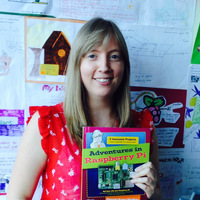Carrie Anne Philbin

I lead the Raspberry Pi Foundation's efforts to support educators with resources and training. I'm an experienced computing teacher, an advocate for diversity in tech, author and a YouTuber.
Location Cambridge, UK
Activity
-
Welcome Renee. A school district approach to Makerspaces sounds really interesting. Looking forward to your insight throughout the course.
-
Carrie Anne Philbin replied to Jesper Juul
Welcome Jesper. Getting started can be the hardest part, but we have lots of tips and tools to help you on this course.
-
Carrie Anne Philbin replied to Ellie Bates
Welcome Ellie. I'm looking forward to your input from a DT point of view!
-
Welcome Babs! I've just returned from Coolest Projects 2019 in Dublin and was blown away by the creativity and technical skills exhibited in the hardware category by so many young people. CoderDojo has really helped them find a home to develop their ideas.
-
Carrie Anne Philbin replied to Melvin Din
@MelvinDin Welcome! Looking forward to more detailed conversation about learning through making.
-
Carrie Anne Philbin replied to Melvin Din
@PauloJorgeMatos Welcome to the course Paulo!
-
Carrie Anne Philbin made a comment
Welcome to the final week of the course! Looking forward to hearing your thoughts and reflections, especially on progression and curriculum.
-
Hi Hubertus, this sounds like a great community resource in a rural area. Have you visited any other similar spaces for inspiration?
-
Measure what matters to help you grow. Thanks for giving your feedback from this week's learning.
-
Amazing growth you've detailed here, with great ideas of where to source support. From 2 to many! I love the idea of getting older students involved. Great for their own development as well as helpful to you and your space.
-
Amazing! Would love to hear what lessons you've learned over the past few years.
-
It's always a good idea to try and do something small scale and see how it goes before committing lots of resource to something. I don't think that is negative. It's practical and forward thinking! That's why it is always good to see these case studies and hear from you, so that we can learn the best lessons for our own contexts and environments.
-
Carrie Anne Philbin replied to Roger Fagg
I agree that to take part in digital making activities you do not need a state of the art markerspace. Access to a desk, some recycled materials and imagination are all thats needed.
-
A trolly makerspace is a wonderful idea for locations like primary school. Why shouldn't the making come to you! Also a great way to keep tools and equipment safely stored away.
-
Absolutely! I see many shopping lists without much thought about what the learners will do and more importantly learn.
-
I like this idea. Students might feel more inspired to help raise funds if they are contributing to the planning and use of the space!
-
Great suggestion!
-
Amazing Marcie! Do you have some examples of what materials families have brought in and what you plan on doing with them?
-
I feel that the maker movement is all about doing something with what you have. I've never had access to a 3D printer, either in a school or in my current role but then I've never needed one to bring my projects to life.
Having a space to be inventive and share knowledge feels more important than the equipment on offer.
-
Funding can often be a barrier to getting started. We have some great suggestions on how to create a space with very little so do not lose heart. You can do this!
-
Great name for a makerspace! Would be great to hear about your experiences and ideas during this course. Especially in week 2 and 3.
-
Carrie Anne Philbin replied to JAWAHAR PATANI
Space to explore different hardware, software, tools and skills will hopefully benefit society in lots of ways. Having a project to do is always a great starting point.
